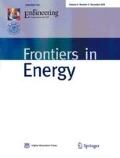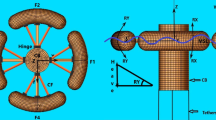Abstract
This paper describes an innovative method of using a non-buoyant body to harness ocean waves. All the point absorbers are buoyant in nature and move up due to buoyancy and come down because of gravity. The point absorbers are designed to move along the waves to make the device efficient. These devices face excessive stress during the rough weather on account of the extreme motion of waves and cause the total device failure. The present study shows that using a non-buoyant body for conventional point absorber principle is much efficient and safer than any other device proposed till today. A small scale wave energy converter with non-buoyant body was designed, fabricated and tested in small scale wave maker. An electrical generator was coupled with the device to generate electrical energy from harnessed waves. The generator was electrically loaded and the generated power was measured. It was found from the experiments that the proposed device showed a significant improvement in electricity generation and safety during extreme conditions. In addition to the electricity generation, the characteristics of the device were also studied by using various wave and device parameters.
Similar content being viewed by others
References
De O Falcão A F. Wave energy utilization: A review of the technologies. Renewable & Sustainable Energy Reviews, 2009, 14(3): 899–918
Falnes J. A review of wave-energy extraction. Marine Structures, 2007, 20(4): 185–201
Eriksson M, Waters R, Svensson O, Isberg J, Leijon M. Wave power absorption: Experiments in open sea and simulation. Journal of Applied Physics, 2007, 102(8): 1–5
Elwood D, Yim S C, Prudell J, Stillinger C, von Jouanne A, Brekken T, Brown A, Paasch R. Design, construction, and ocean testing of a taut-moored dual-body wave energy converter with a linear generator power take-off. Renewable Energy, 2010, 35(2): 348–354
Agamloh E B, Wallace A K, von Jouanne A. A novel direct-drive ocean wave energy extraction concept with contact-less force transmission system. Renewable Energy, 2008, 33(3): 520–529
Polinder H, Damen M E C, Gardner F. Linear PM generator system for wave energy conversion in the AWS. Energy, 2004, 19(3): 583–589
Vantorre M, Banasiak R, Verhoeven R. Modelling of hydraulic performance and wave energy extraction by a point absorber in heave. Applied Ocean Research, 2004, 26(1): 61–72
Eriksson M, Isberg J, Leijon M. Hydrodynamic modelling of a direct drive wave energy converter. International Journal of Engineering Science, 2005, 43(17): 1377–1387
Bjarte-Larsson T, Flanes J. Laboratory experiment on heaving body with hydraulic power take-off and latching control. Ocean Engineering, 2006, 33(7): 847–877
Stallard T J, Weller S D, Stansby P K. Limiting heave response of a wave energy device by draft adjustment with upper surface immersion. Applied Ocean Research, 2009, 31(4): 282–289
Author information
Authors and Affiliations
Corresponding author
Rights and permissions
About this article
Cite this article
Amarkarthik, A., Chandrasekaran, S., Sivakumar, K. et al. Laboratory experiment on using non-floating body to generate electrical energy from water waves. Front. Energy 6, 361–365 (2012). https://doi.org/10.1007/s11708-012-0210-1
Received:
Accepted:
Published:
Issue Date:
DOI: https://doi.org/10.1007/s11708-012-0210-1



